Carangids (Trevallies)
Jacks, scads, trevallies, queenfishes, runners, amberjacks, pilotfishes, pampanos and etc. are the members of the Carangidae family. The family members are made up of many highly variable body shape fish species. The Carangidae are distinguished from all other similar families in having the first 2 anal fin spines detached from rest of fin. These spines are sometimes partially or completely embedded in large adults of several genera, especially Seriola, Alectis, and Caranx and can only be found by dissection. Most species have spiny scutes along lateral line.
The carangids are marine fishes found in the Atlantic, Indian and Pacific oceans. Their habitats and behaviour are highly variable. Most of them are schooling species. Most species are fast swimming predators that hunt at or near the surface, mostly in oceanic waters, and often far offshore. Some root in sand for invertebrates and fishes.
There are altogether 30 genera and 147 species in the Carangidae family worldwide. There are 19 genera and about 61 species found in Malaysia.
The family has four subfamilies, Caranginae consist of a mixtures of 20 genera and 104 species like the threadfishes, trevallies, scads, horse mackerels, moonfishes, black pomfret, and etc. Naucratinae consist of 5 genera and 13 species also with many mixtures. Trachinotinae consist of 2 genera and 21 species of mostly pompanos. Scomberoidinae consist of 3 genera and 10 species of queenfishes (leatherjackets).
This page shows the species commonly called trevallies.
The carangids are marine fishes found in the Atlantic, Indian and Pacific oceans. Their habitats and behaviour are highly variable. Most of them are schooling species. Most species are fast swimming predators that hunt at or near the surface, mostly in oceanic waters, and often far offshore. Some root in sand for invertebrates and fishes.
There are altogether 30 genera and 147 species in the Carangidae family worldwide. There are 19 genera and about 61 species found in Malaysia.
The family has four subfamilies, Caranginae consist of a mixtures of 20 genera and 104 species like the threadfishes, trevallies, scads, horse mackerels, moonfishes, black pomfret, and etc. Naucratinae consist of 5 genera and 13 species also with many mixtures. Trachinotinae consist of 2 genera and 21 species of mostly pompanos. Scomberoidinae consist of 3 genera and 10 species of queenfishes (leatherjackets).
This page shows the species commonly called trevallies.
Scientific Name: Alectis ciliaris (Bloch, 1787)
English Name: African Pompano, Threadfin Trevally, Round-headed Pennantfish
Chinese Name | 鱼类中文名: 长丝镜(Cháng sī jìng), 镜鱼 (Jìng yú), 大眼照明 (Dà yǎn zhào míng), 旗子鲳 (Qízi chāng)
Malay Name | Nama Melayu Malaysia: Ebek, Rambai Ebek
Bahasa Indonesia: Ikan Kwee Rambut, Cakal Putri
Thai Name | ชื่อสามัญภาษาไทย: ปลาโฉมงาม (Plā c̄homngām), ปลาผมนางลาย (Plā p̄hmnāng lāy)
Main Identification Features: Body deep and very compressed. Profile of nape and head broadly rounded. Snout slightly convex. Black blotch on the front part of the dorsal fin. Juvenile diamond-shaped with long dorsal and anal fins filaments but lack pelvic fin filaments. The filaments gradually reduce as the fish grows and are absent in adult.
Size: Maximum total length about 150 cm, commonly to 100 cm.
Habitat and Ecology: Coastal waters, to 100 m depth. Feeds mainly on fishes and crustaceans.
Remarks: The valid Malay name in Malaysia for this fish is Rambai Ebek but it is widely known among fishermen and anglers as Sagai.

Adult

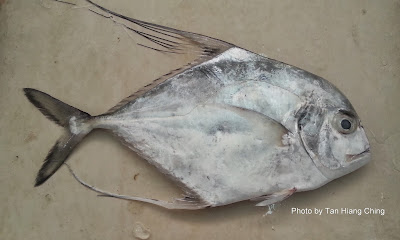
Juvenile
Scientific Name: Alectis indica (Rüppell, 1830)
English Name: Indian Threadfish, Diamond Trevally
Chinese Name | 鱼类中文名: 斧头鲳(Fǔtóu chāng), 镜鱼 (Jìng yú), 照明 (Zhào míng), 旗子鲳 (Qízi chāng)
Malay Name | Nama Melayu Malaysia: Sagai, Rambai Sagai
Bahasa Indonesia: Ikan Kwee Rombeh, Kwe Mangmung, Cakal Kaca
Thai Name | ชื่อสามัญภาษาไทย: ปลาโฉมงามหน้าหัก (Plā c̄homngām h̄n̂ā h̄ạk), ปลาผมนางหน้าตัด (Plā p̄hmnāng h̄n̂ā tạd)
Main Identification Features: Body angular and strongly compressed. Profile of nape and head somewhat angular. Snout slightly concave. Juvenile diamond-shaped with long dorsal, anal and pelvic fins filaments. The filaments gradually reduce as the fish grows and are absent in adult.
Size: Maximum total length 150 cm.
Habitat and Ecology: Coastal waters, to 100 m depth. Feeds mainly on fishes, squids, and crustaceans.
Remarks: The valid Malay name in Malaysia for this fish is Rambai Sagai but it is widely known among fishermen and anglers as Ebek.

Adult

Juvenile
Click button below to see more fish info and photo.
More
Scientific Name: Atropus atropos (Bloch & Schneider, 1801)
English Name: Cleftbelly Trevally, Thin Crevalle
Chinese Name | 鱼类中文名: 黑旗鲳 (Hēi qí chāng), 铜镜 (Tóng jìng), 沟鲹 (Gōu shēn)
Malay Name | Nama Melayu Malaysia: Ikan Cupak, Putih, Kuweh
Bahasa Indonesia: Ikan Putihan
Thai Name | ชื่อสามัญภาษาไทย: ปลาตะโกรงขาว (Plā takorong k̄hāw)
Main Identification Features: Belly with a deep median groove which fit pelvic fins, anus, and anal-fin spines. Pelvic fins long and black. Scutes are present along its straight lateral line. Curved lateral line short.
Size: Maximum total length 26.5 cm.
Habitat and Ecology: Pelagic species that inhabits shallow coastal waters. Regularly found swimming near the surface. Feeds primarily on shrimps, copepods, decapod crustaceans, and small fishes.


Scientific Name: Carangoides armatus (Rüppell, 1830)
English Name: Longfin Trevally
Chinese Name | 鱼类中文名: 镜鲳 (Jìng chāng), 甲若鰺 (Jiǎ ruò shēn)
Malay Name | Nama Melayu Malaysia: Ikan Cermin, Sagai, Rambai, Cermin, Cupak, Demudok Putih
Bahasa Indonesia: Ikan Kwee, Putihan
Thai Name | ชื่อสามัญภาษาไทย: ปลาจุยจินขาว (Plā cuy cin k̄hāw)
Main Identification Features: Head profile very steep in adults but relatively straight from snout to nape. Breast naked area extends diagonally to base of pectoral fin but not above the pectoral fin. Lobe of second dorsal fin elongate and filamentous.
Size: Maximum fork length about 50 cm.
Habitat and Ecology: Coastal rocky and coral reefs, to 59 m depth. Adults often swim along the edges of reefs in small groups. Juveniles may occur in estuarine areas. Feeds mainly on crustaceans and juvenile fishes.
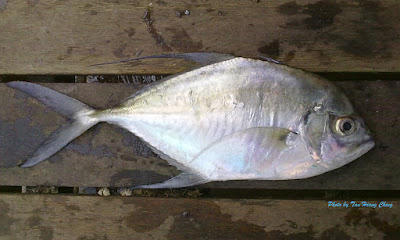
Scientific Name: Carangoides chrysophrys (Cuvier, 1833)
English Name: Longnose Trevally, Club-nosed Trevally, Grunting Trevally
Chinese Name | 鱼类中文名: 镜鲳 (Jìng chāng), 长吻若鲹 (Zhǎng wěn ruò shēn)
Malay Name | Nama Melayu Malaysia: Ikan Cupak, Demudok Muncung, Rambai Landeh
Bahasa Indonesia: Ikan Kwee, Putihan
Thai Name | ชื่อสามัญภาษาไทย: ปลาสีกุนป้อม (Plā s̄īkun p̂om)
Main Identification Features: Opercle with black spot. Body deep, head profile gently sloping but vertical just above mouth. Scaleless breast to behind pelvic origin and laterally to pectoral base. Long pectoral fins that extend to the straight part of the lateral line.
Size: Maximum fork length to 72 cm, commonly 65 cm total length.
Habitat and Ecology: Coastal water, to 90 m depth, but most abundant from 30 to 60 m depth. Adults inhabit open waters of coastal reefs. Juveniles occur in inshore areas, including estuaries. Usually in small groups. Feeds on small demersal fishes and epibenthic crustaceans.


Scientific Name: Carangoides coeruleopinnatus (Rüppell, 1830)
English Name: Coastal Trevally, Onion Trevally, Blue-spined Trevally
Chinese Name | 鱼类中文名: 镜鲳 (Jìng chāng), 青羽若鲹 (Qīng yǔ ruò shēn)
Malay Name | Nama Melayu Malaysia: Ikan Cermin, Cupak, Demudok Cupak
Bahasa Indonesia: Ikan Kwee, Putihan
Thai Name | ชื่อสามัญภาษาไทย: ปลาสีกุน (Plā s̄īkun), ปลาม่ง (Plā m̀ng)
Main Identification Features: Bluish green above, silvery grey below. Sides with numerous, small yellow spots. Small black blotch on upper margin of opercle. Head profile curved to nape. Non-scaled area on breast extending to pectoral-fin base but not above. Juveniles have a filamentous lobe on the second dorsal fin.
Size: Maximum total length to 41 cm, commonly to 30 cm total length.
Habitat and Ecology: Coral reefs, to 150 m depth. Usually in small groups over sand bottoms near reefs, rarely found inshore.


Scientific Name: Carangoides fulvoguttatus (Forsskål, 1775)
English Name: Yellowspotted Trevally, Turrum
Chinese Name | 鱼类中文名: 花点水鲳 (Huā diǎn shuǐ chāng), 星點若鰺 (Xīng diǎn ruò shēn)
Malay Name | Nama Melayu Malaysia: Ikan Sagai, Cermin, Cupak, Demudok Bintik Kuning
Bahasa Indonesia: Ikan Kwee Macan
Thai Name | ชื่อสามัญภาษาไทย: ปลาสีกุนจุดเหลือง (Plā s̄īkun cud h̄elụ̄xng)
Main Identification Features: Profile of head and nape slightly angular becoming more steep with age. Lower margin of eye well above snout tip. Many small golden or brassy spots mainly above midline. Large individuals often with 3 irregular black blotches.
Size: Maximum total length about 90 cm.
Habitat and Ecology: Rocky and coral reefs, to 100 m depth. Often in small to large schools, but also solitary. Feeds on small invertebrates and fishes.



Scientific Name: Carangoides gymnostethus (Cuvier, 1833)
English Name: Bludger
Chinese Name | 鱼类中文名: 镜鲳 (Jìng chāng), 裸胸若鰺 (Luǒ xiōng ruò shēn)
Malay Name | Nama Melayu Malaysia: Ikan Cermin, Cupak, Ewe Karm, Demudok Nyior-nyior
Bahasa Indonesia: Ikan Kwee Lilin, Tangkolak
Thai Name | ชื่อสามัญภาษาไทย: ปลาสีกุนกลม (Plā s̄īkun klm), ปลาม่งกลม (Plā m̀ng klm), มงหัวกลม (Mng h̄ạw klm)
Main Identification Features: Profile of head and nape gently convex becoming less steep with age. Lower margin of eye at level of snout tip. A few brown or golden spots sometimes present midlaterally.
Size: Maximum total length about 90 cm.
Habitat and Ecology: Reef associated coastal to deep waters, to 100 m depth. Larger individuals are generally solitary, while juveniles form small schools. Feeds on small invertebrates and fishes.
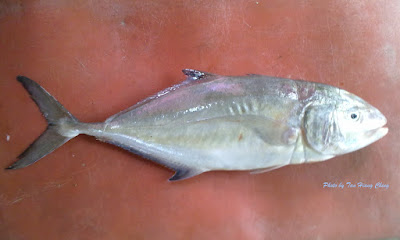


Scientific Name: Carangoides hedlandensis (Whitley, 1934)
English Name: Bumpnose Trevally
Malay Name | Nama Melayu Malaysia: Ikan Demudok, Putih, Demudok Lekuk
Bahasa Indonesia: Ikan Semar
Thai Name | ชื่อสามัญภาษาไทย: ปลาสีกุนครีบยาว (Plā s̄īkun khrīb yāw), ปลามงแซ่ (Plā mng sæ̀), ปลาผมนาง (Plā p̄hmnāng)
Main Identification Features: Head profile extremely steep in adults, with a distinct hump forward of eyes. Eye large, diameter about equal to, or larger than snout length. Lobe of second dorsal fin elongate and filamentous.
Size: Maximum fork length about 28 cm.
Habitat and Ecology: Coastal waters, to 80 m depth. A semidemersal species, living above the seafloor.


Scientific Name: Carangoides malabaricus (Bloch & Schneider, 1801)
English Name: Malabar Trevally
Malay Name | Nama Melayu Malaysia: Ikan Rambai, Cupak, Putih, Cermin, Demudok, Demudok Cermin
Bahasa Indonesia: Ikan Kuweh
Thai Name | ชื่อสามัญภาษาไทย: ปลากะมงปากบาง (Plā ka mng pāk bāng)
Local Hokkien: Ngiau Chu Kam
Main Identification Features: Body deep and almost ovate. Opercle with a small black spot on upper margin. Breast naked area extends diagonally above the pectoral fin. Tongue greyish brown to brown.
Size: Maximum fork length about 24 cm.
Habitat and Ecology: Coral and rocky reefs, 20 to 140 m depth. Feeds on crustaceans, small squids, and fishes.

Scientific Name: Carangoides plagiotaenia Bleeker, 1857
English Name: Barcheek Trevally
Chinese Name | 鱼类中文名: 镜鲳 (Jìng chāng), 斜条鲹 (Xié tiáo shēn)
Malay Name | Nama Melayu Malaysia: Ikan Sagai, Cermin, Cupak, Demudok Pipi Calit
Thai Name | ชื่อสามัญภาษาไทย: ปลากะมงแก้มหนา (Plā ka mng kæ̂m h̄nā)
Main Identification Features: Lower jaw somewhat enlarged and projecting beyond upper jaw. No opercular spot but adults with posterior margin of preopercle distinctly dark to black.
Size: Maximum total length about 42 cm.
Habitat and Ecology: Shallow water along edges of steep outer reef and lagoon slopes, to 200 m depth. Found singly or in groups.

Scientific Name: Carangoides praeustus (Anonymous [Bennett], 1830)
English Name: Brownback Trevally
Malay Name | Nama Melayu Malaysia: Ikan Cupak, Putih, Demudok Abu-abu
Bahasa Indonesia: Ikan Selar Malam
Thai Name | ชื่อสามัญภาษาไทย: ปลาสีกุนเล็กครีบดำ (Plā s̄īkun lĕk khrīb dả)
Main Identification Features: Distal half of second dorsal-fin lobe abruptly black, sometimes with a white margin.
Size: Maximum total length about 22 cm.
Habitat and Ecology: Primarily coastal water areas. Juveniles have been recorded in estuaries. Feeds mainly on crustaceans.

Scientific Name: Caranx ignobilis (Forsskål, 1775)
English Name: Giant Trevally
Chinese Name | 鱼类中文名: 金骨 (Jīn gǔ), 牛公鲳 (Niú gōng chāng), 牛港鲳 (Niú gǎng chāng)
Malay Name | Nama Melayu Malaysia: Ikan Gerepuh, Putih, Belukok Mamong
Bahasa Indonesia: Ikan Gerepoh, Meye, Gapok
Thai Name | ชื่อสามัญภาษาไทย: ปลากะมงพร้าว (Plā ka mng phr̂āw), ปลากะมงยักษ์ (Plā ka mng yạks̄), ปลาตะคองยักษ์ (Plā ta khxng yạks̄)
Local Hokkien: Gu Kang Cheoh
Main Identification Features: End of upper jaw extends to posterior edge of pupil or a little beyond. Adults with head and body silvery grey to black above. Head profile steep and straight. Body covered with numerous black dots.
Size: Maximum total length 146 cm.
Habitat and Ecology: Often close to reefs, to 190 m depth. Adults solitary or in schools. Juveniles occur in small schools over sandy inshore bottoms and occasionally in estuaries. Feeds during the day, mostly on demersal and pelagic fishes. Also consumes cephalopods, crustaceans and other animals, including birds.

Juvenile

Subadult

Adult
Scientific Name: Caranx melampygus Cuvier, 1833
English Name: Bluefin Trevally
Chinese Name | 鱼类中文名: 蓝鳍金骨 (Lán qí jīn gǔ)
Malay Name | Nama Melayu Malaysia: Belukok Sirip Biru, Demudok, Kerepoh
Bahasa Indonesia: Ikan Kwee Sirip Biru, Langguran, Puka Putih
Thai Name | ชื่อสามัญภาษาไทย: ปลากะมงครีบฟ้า (Plā ka mng khrīb f̂ā)
Main Identification Features: Adults with head and dorsal half of body brassy, suffused with blue, and covered with small blue black spots. Second dorsal, anal, and caudal fins electric blue.
Size: Maximum total length about 80 cm.
Habitat and Ecology: Close to reefs, to 190 m depth. Found solitary, in pairs, and in small groups. Feeds primarily on reef fishes and crustaceans.

Scientific Name: Caranx papuensis Alleyne & MacLeay, 1877
English Name: Brassy Trevally
Malay Name | Nama Melayu Malaysia: Belukok Bintik Hitam, Belukok Papua
Bahasa Indonesia: Ikan Kwee Papua
Main Identification Features: Adults with head and dorsal half of body brassy, with small dark spots (more numerous with increasing size). Upper lobe of tail usually uniformly pigmented, lower tail lobe with narrow white or yellowish margin. Conspicuous silvery white spot at the intersection of opercle and lateral line.
Size: Maximum total length about 88 cm.
Habitat and Ecology: Close to reefs, to 100 m depth. Juveniles found in estuaries. Found solitary, and in small groups. Feeds primarily on fishes.

Scientific Name: Caranx sexfasciatus Quoy & Gaimard, 1825
English Name: Bigeye Trevally
Malay Name | Nama Melayu Malaysia: Ikan Cupak, Belukok Putih, Kerepoh
Thai Name | ชื่อสามัญภาษาไทย: ปลาหางกิ่วหม้อ (Plā h̄āngkìw h̄m̂x)
Main Identification Features: Breast completely scaly. Small blackish spot at upper angle of opercle. Upper half of body without small dark spots. Second dorsal fin olive to blackish, the lobe with a white tip (becoming more obvious with size). Anal fin with white tip.
Size: Maximum fork length 78 cm, commonly to about 60 cm.
Habitat and Ecology: Close to reefs, to 150 m depth. Juveniles found in estuaries. A schooling fish, with aggregations consisting of more than 1500 fish. Forms large, semi-stationary schools during daytime and disperses to feed at night or during twilight periods. Feeds primarily on fishes, squids and crustaceans.
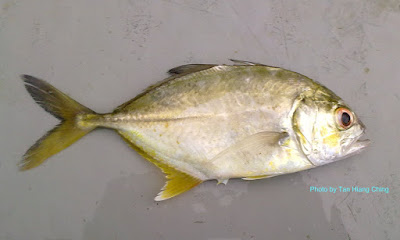
Juvenile

Adult
Scientific Name: Gnathanodon speciosus (Forsskål, 1775)
English Name: Golden Trevally, Golden Jack
Chinese Name | 鱼类中文名: 黄合鲳 (Huáng hé chāng)
Malay Name | Nama Melayu Malaysia: Ikan Gomblang, Gerong-gerong, Kalakitok, Kerong, Gerong Belang
Bahasa Indonesia: Ikan Pidana, Kwee, Badong, Betonan
Thai Name | ชื่อสามัญภาษาไทย: ปลาตะคองเหลือง (Plā ta khxng h̄elụ̄xng), ปลาทูทอง (Plā thū thxng)
Local Hokkien: Boon Nang, Boon Hong
Main Identification Features: Lips papillose and upper jaw strongly protactile. 7 to 11 black bands that fade with age. The first band oblique through eye. All fins yellow.
Size: Maximum fork length to about 100 cm.
Habitat and Ecology: Coastal waters, to 80 m depth. Juveniles display piloting behavior with sharks, and other large fishes. Both juveniles and adults are occasionally seen over sandy areas where they use their highly protractile mouth to root the sand and small crevices for crustaceans, molluscs and small fish.

Juvenile
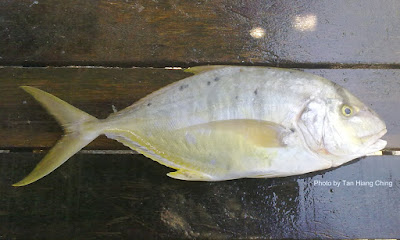
Adult
Scientific Name: Ulua mentalis (Cuvier, 1833)
English Name: Longrakered Trevally
Chinese Name | 鱼类中文名: 镜鲳 (Jìng chāng), 羽鰓鰺 (Yǔ sāi shēn), 丝口鲹 (Sī kǒu shēn)
Malay Name | Nama Melayu Malaysia: Ikan Cermin, Sagai Dagu, Sagai Mulut Hitam
Bahasa Indonesia: Ikan Terman, Sulir, Salem, Cakal
Thai Name | ชื่อสามัญภาษาไทย: ปลาจุยจินเหงือกยาว (Plā cuy ci n h̄engụ̄xk yāw), มงปากกว้าง (Mng pākkŵāng)
Main Identification Features: Lower jaw prominent in large adults. The angle of “chin” projecting beyond upper jaw. Spinous dorsal and caudal fins dusky to black. Adults with a dusky mark on cheek at angle of jaws.
Size: Maximum total length 100 cm, commonly to about 60 cm.
Habitat and Ecology: Shallow coastal waters, close to reef, to 100 m depth. Feeds primarily on crustaceans and fishes.

English Name: African Pompano, Threadfin Trevally, Round-headed Pennantfish
Chinese Name | 鱼类中文名: 长丝镜(Cháng sī jìng), 镜鱼 (Jìng yú), 大眼照明 (Dà yǎn zhào míng), 旗子鲳 (Qízi chāng)
Malay Name | Nama Melayu Malaysia: Ebek, Rambai Ebek
Bahasa Indonesia: Ikan Kwee Rambut, Cakal Putri
Thai Name | ชื่อสามัญภาษาไทย: ปลาโฉมงาม (Plā c̄homngām), ปลาผมนางลาย (Plā p̄hmnāng lāy)
Main Identification Features: Body deep and very compressed. Profile of nape and head broadly rounded. Snout slightly convex. Black blotch on the front part of the dorsal fin. Juvenile diamond-shaped with long dorsal and anal fins filaments but lack pelvic fin filaments. The filaments gradually reduce as the fish grows and are absent in adult.
Size: Maximum total length about 150 cm, commonly to 100 cm.
Habitat and Ecology: Coastal waters, to 100 m depth. Feeds mainly on fishes and crustaceans.
Remarks: The valid Malay name in Malaysia for this fish is Rambai Ebek but it is widely known among fishermen and anglers as Sagai.
Adult

Juvenile
Scientific Name: Alectis indica (Rüppell, 1830)
English Name: Indian Threadfish, Diamond Trevally
Chinese Name | 鱼类中文名: 斧头鲳(Fǔtóu chāng), 镜鱼 (Jìng yú), 照明 (Zhào míng), 旗子鲳 (Qízi chāng)
Malay Name | Nama Melayu Malaysia: Sagai, Rambai Sagai
Bahasa Indonesia: Ikan Kwee Rombeh, Kwe Mangmung, Cakal Kaca
Thai Name | ชื่อสามัญภาษาไทย: ปลาโฉมงามหน้าหัก (Plā c̄homngām h̄n̂ā h̄ạk), ปลาผมนางหน้าตัด (Plā p̄hmnāng h̄n̂ā tạd)
Main Identification Features: Body angular and strongly compressed. Profile of nape and head somewhat angular. Snout slightly concave. Juvenile diamond-shaped with long dorsal, anal and pelvic fins filaments. The filaments gradually reduce as the fish grows and are absent in adult.
Size: Maximum total length 150 cm.
Habitat and Ecology: Coastal waters, to 100 m depth. Feeds mainly on fishes, squids, and crustaceans.
Remarks: The valid Malay name in Malaysia for this fish is Rambai Sagai but it is widely known among fishermen and anglers as Ebek.

Adult

Juvenile
Click button below to see more fish info and photo.
More
Scientific Name: Atropus atropos (Bloch & Schneider, 1801)
English Name: Cleftbelly Trevally, Thin Crevalle
Chinese Name | 鱼类中文名: 黑旗鲳 (Hēi qí chāng), 铜镜 (Tóng jìng), 沟鲹 (Gōu shēn)
Malay Name | Nama Melayu Malaysia: Ikan Cupak, Putih, Kuweh
Bahasa Indonesia: Ikan Putihan
Thai Name | ชื่อสามัญภาษาไทย: ปลาตะโกรงขาว (Plā takorong k̄hāw)
Main Identification Features: Belly with a deep median groove which fit pelvic fins, anus, and anal-fin spines. Pelvic fins long and black. Scutes are present along its straight lateral line. Curved lateral line short.
Size: Maximum total length 26.5 cm.
Habitat and Ecology: Pelagic species that inhabits shallow coastal waters. Regularly found swimming near the surface. Feeds primarily on shrimps, copepods, decapod crustaceans, and small fishes.
Scientific Name: Carangoides armatus (Rüppell, 1830)
English Name: Longfin Trevally
Chinese Name | 鱼类中文名: 镜鲳 (Jìng chāng), 甲若鰺 (Jiǎ ruò shēn)
Malay Name | Nama Melayu Malaysia: Ikan Cermin, Sagai, Rambai, Cermin, Cupak, Demudok Putih
Bahasa Indonesia: Ikan Kwee, Putihan
Thai Name | ชื่อสามัญภาษาไทย: ปลาจุยจินขาว (Plā cuy cin k̄hāw)
Main Identification Features: Head profile very steep in adults but relatively straight from snout to nape. Breast naked area extends diagonally to base of pectoral fin but not above the pectoral fin. Lobe of second dorsal fin elongate and filamentous.
Size: Maximum fork length about 50 cm.
Habitat and Ecology: Coastal rocky and coral reefs, to 59 m depth. Adults often swim along the edges of reefs in small groups. Juveniles may occur in estuarine areas. Feeds mainly on crustaceans and juvenile fishes.

Scientific Name: Carangoides chrysophrys (Cuvier, 1833)
English Name: Longnose Trevally, Club-nosed Trevally, Grunting Trevally
Chinese Name | 鱼类中文名: 镜鲳 (Jìng chāng), 长吻若鲹 (Zhǎng wěn ruò shēn)
Malay Name | Nama Melayu Malaysia: Ikan Cupak, Demudok Muncung, Rambai Landeh
Bahasa Indonesia: Ikan Kwee, Putihan
Thai Name | ชื่อสามัญภาษาไทย: ปลาสีกุนป้อม (Plā s̄īkun p̂om)
Main Identification Features: Opercle with black spot. Body deep, head profile gently sloping but vertical just above mouth. Scaleless breast to behind pelvic origin and laterally to pectoral base. Long pectoral fins that extend to the straight part of the lateral line.
Size: Maximum fork length to 72 cm, commonly 65 cm total length.
Habitat and Ecology: Coastal water, to 90 m depth, but most abundant from 30 to 60 m depth. Adults inhabit open waters of coastal reefs. Juveniles occur in inshore areas, including estuaries. Usually in small groups. Feeds on small demersal fishes and epibenthic crustaceans.
Scientific Name: Carangoides coeruleopinnatus (Rüppell, 1830)
English Name: Coastal Trevally, Onion Trevally, Blue-spined Trevally
Chinese Name | 鱼类中文名: 镜鲳 (Jìng chāng), 青羽若鲹 (Qīng yǔ ruò shēn)
Malay Name | Nama Melayu Malaysia: Ikan Cermin, Cupak, Demudok Cupak
Bahasa Indonesia: Ikan Kwee, Putihan
Thai Name | ชื่อสามัญภาษาไทย: ปลาสีกุน (Plā s̄īkun), ปลาม่ง (Plā m̀ng)
Main Identification Features: Bluish green above, silvery grey below. Sides with numerous, small yellow spots. Small black blotch on upper margin of opercle. Head profile curved to nape. Non-scaled area on breast extending to pectoral-fin base but not above. Juveniles have a filamentous lobe on the second dorsal fin.
Size: Maximum total length to 41 cm, commonly to 30 cm total length.
Habitat and Ecology: Coral reefs, to 150 m depth. Usually in small groups over sand bottoms near reefs, rarely found inshore.
Scientific Name: Carangoides fulvoguttatus (Forsskål, 1775)
English Name: Yellowspotted Trevally, Turrum
Chinese Name | 鱼类中文名: 花点水鲳 (Huā diǎn shuǐ chāng), 星點若鰺 (Xīng diǎn ruò shēn)
Malay Name | Nama Melayu Malaysia: Ikan Sagai, Cermin, Cupak, Demudok Bintik Kuning
Bahasa Indonesia: Ikan Kwee Macan
Thai Name | ชื่อสามัญภาษาไทย: ปลาสีกุนจุดเหลือง (Plā s̄īkun cud h̄elụ̄xng)
Main Identification Features: Profile of head and nape slightly angular becoming more steep with age. Lower margin of eye well above snout tip. Many small golden or brassy spots mainly above midline. Large individuals often with 3 irregular black blotches.
Size: Maximum total length about 90 cm.
Habitat and Ecology: Rocky and coral reefs, to 100 m depth. Often in small to large schools, but also solitary. Feeds on small invertebrates and fishes.

Scientific Name: Carangoides gymnostethus (Cuvier, 1833)
English Name: Bludger
Chinese Name | 鱼类中文名: 镜鲳 (Jìng chāng), 裸胸若鰺 (Luǒ xiōng ruò shēn)
Malay Name | Nama Melayu Malaysia: Ikan Cermin, Cupak, Ewe Karm, Demudok Nyior-nyior
Bahasa Indonesia: Ikan Kwee Lilin, Tangkolak
Thai Name | ชื่อสามัญภาษาไทย: ปลาสีกุนกลม (Plā s̄īkun klm), ปลาม่งกลม (Plā m̀ng klm), มงหัวกลม (Mng h̄ạw klm)
Main Identification Features: Profile of head and nape gently convex becoming less steep with age. Lower margin of eye at level of snout tip. A few brown or golden spots sometimes present midlaterally.
Size: Maximum total length about 90 cm.
Habitat and Ecology: Reef associated coastal to deep waters, to 100 m depth. Larger individuals are generally solitary, while juveniles form small schools. Feeds on small invertebrates and fishes.

Scientific Name: Carangoides hedlandensis (Whitley, 1934)
English Name: Bumpnose Trevally
Malay Name | Nama Melayu Malaysia: Ikan Demudok, Putih, Demudok Lekuk
Bahasa Indonesia: Ikan Semar
Thai Name | ชื่อสามัญภาษาไทย: ปลาสีกุนครีบยาว (Plā s̄īkun khrīb yāw), ปลามงแซ่ (Plā mng sæ̀), ปลาผมนาง (Plā p̄hmnāng)
Main Identification Features: Head profile extremely steep in adults, with a distinct hump forward of eyes. Eye large, diameter about equal to, or larger than snout length. Lobe of second dorsal fin elongate and filamentous.
Size: Maximum fork length about 28 cm.
Habitat and Ecology: Coastal waters, to 80 m depth. A semidemersal species, living above the seafloor.


Scientific Name: Carangoides malabaricus (Bloch & Schneider, 1801)
English Name: Malabar Trevally
Malay Name | Nama Melayu Malaysia: Ikan Rambai, Cupak, Putih, Cermin, Demudok, Demudok Cermin
Bahasa Indonesia: Ikan Kuweh
Thai Name | ชื่อสามัญภาษาไทย: ปลากะมงปากบาง (Plā ka mng pāk bāng)
Local Hokkien: Ngiau Chu Kam
Main Identification Features: Body deep and almost ovate. Opercle with a small black spot on upper margin. Breast naked area extends diagonally above the pectoral fin. Tongue greyish brown to brown.
Size: Maximum fork length about 24 cm.
Habitat and Ecology: Coral and rocky reefs, 20 to 140 m depth. Feeds on crustaceans, small squids, and fishes.

Scientific Name: Carangoides plagiotaenia Bleeker, 1857
English Name: Barcheek Trevally
Chinese Name | 鱼类中文名: 镜鲳 (Jìng chāng), 斜条鲹 (Xié tiáo shēn)
Malay Name | Nama Melayu Malaysia: Ikan Sagai, Cermin, Cupak, Demudok Pipi Calit
Thai Name | ชื่อสามัญภาษาไทย: ปลากะมงแก้มหนา (Plā ka mng kæ̂m h̄nā)
Main Identification Features: Lower jaw somewhat enlarged and projecting beyond upper jaw. No opercular spot but adults with posterior margin of preopercle distinctly dark to black.
Size: Maximum total length about 42 cm.
Habitat and Ecology: Shallow water along edges of steep outer reef and lagoon slopes, to 200 m depth. Found singly or in groups.

Scientific Name: Carangoides praeustus (Anonymous [Bennett], 1830)
English Name: Brownback Trevally
Malay Name | Nama Melayu Malaysia: Ikan Cupak, Putih, Demudok Abu-abu
Bahasa Indonesia: Ikan Selar Malam
Thai Name | ชื่อสามัญภาษาไทย: ปลาสีกุนเล็กครีบดำ (Plā s̄īkun lĕk khrīb dả)
Main Identification Features: Distal half of second dorsal-fin lobe abruptly black, sometimes with a white margin.
Size: Maximum total length about 22 cm.
Habitat and Ecology: Primarily coastal water areas. Juveniles have been recorded in estuaries. Feeds mainly on crustaceans.

Scientific Name: Caranx ignobilis (Forsskål, 1775)
English Name: Giant Trevally
Chinese Name | 鱼类中文名: 金骨 (Jīn gǔ), 牛公鲳 (Niú gōng chāng), 牛港鲳 (Niú gǎng chāng)
Malay Name | Nama Melayu Malaysia: Ikan Gerepuh, Putih, Belukok Mamong
Bahasa Indonesia: Ikan Gerepoh, Meye, Gapok
Thai Name | ชื่อสามัญภาษาไทย: ปลากะมงพร้าว (Plā ka mng phr̂āw), ปลากะมงยักษ์ (Plā ka mng yạks̄), ปลาตะคองยักษ์ (Plā ta khxng yạks̄)
Local Hokkien: Gu Kang Cheoh
Main Identification Features: End of upper jaw extends to posterior edge of pupil or a little beyond. Adults with head and body silvery grey to black above. Head profile steep and straight. Body covered with numerous black dots.
Size: Maximum total length 146 cm.
Habitat and Ecology: Often close to reefs, to 190 m depth. Adults solitary or in schools. Juveniles occur in small schools over sandy inshore bottoms and occasionally in estuaries. Feeds during the day, mostly on demersal and pelagic fishes. Also consumes cephalopods, crustaceans and other animals, including birds.

Juvenile
Subadult

Adult
Scientific Name: Caranx melampygus Cuvier, 1833
English Name: Bluefin Trevally
Chinese Name | 鱼类中文名: 蓝鳍金骨 (Lán qí jīn gǔ)
Malay Name | Nama Melayu Malaysia: Belukok Sirip Biru, Demudok, Kerepoh
Bahasa Indonesia: Ikan Kwee Sirip Biru, Langguran, Puka Putih
Thai Name | ชื่อสามัญภาษาไทย: ปลากะมงครีบฟ้า (Plā ka mng khrīb f̂ā)
Main Identification Features: Adults with head and dorsal half of body brassy, suffused with blue, and covered with small blue black spots. Second dorsal, anal, and caudal fins electric blue.
Size: Maximum total length about 80 cm.
Habitat and Ecology: Close to reefs, to 190 m depth. Found solitary, in pairs, and in small groups. Feeds primarily on reef fishes and crustaceans.

Scientific Name: Caranx papuensis Alleyne & MacLeay, 1877
English Name: Brassy Trevally
Malay Name | Nama Melayu Malaysia: Belukok Bintik Hitam, Belukok Papua
Bahasa Indonesia: Ikan Kwee Papua
Main Identification Features: Adults with head and dorsal half of body brassy, with small dark spots (more numerous with increasing size). Upper lobe of tail usually uniformly pigmented, lower tail lobe with narrow white or yellowish margin. Conspicuous silvery white spot at the intersection of opercle and lateral line.
Size: Maximum total length about 88 cm.
Habitat and Ecology: Close to reefs, to 100 m depth. Juveniles found in estuaries. Found solitary, and in small groups. Feeds primarily on fishes.
Scientific Name: Caranx sexfasciatus Quoy & Gaimard, 1825
English Name: Bigeye Trevally
Malay Name | Nama Melayu Malaysia: Ikan Cupak, Belukok Putih, Kerepoh
Thai Name | ชื่อสามัญภาษาไทย: ปลาหางกิ่วหม้อ (Plā h̄āngkìw h̄m̂x)
Main Identification Features: Breast completely scaly. Small blackish spot at upper angle of opercle. Upper half of body without small dark spots. Second dorsal fin olive to blackish, the lobe with a white tip (becoming more obvious with size). Anal fin with white tip.
Size: Maximum fork length 78 cm, commonly to about 60 cm.
Habitat and Ecology: Close to reefs, to 150 m depth. Juveniles found in estuaries. A schooling fish, with aggregations consisting of more than 1500 fish. Forms large, semi-stationary schools during daytime and disperses to feed at night or during twilight periods. Feeds primarily on fishes, squids and crustaceans.

Juvenile
Adult
Scientific Name: Gnathanodon speciosus (Forsskål, 1775)
English Name: Golden Trevally, Golden Jack
Chinese Name | 鱼类中文名: 黄合鲳 (Huáng hé chāng)
Malay Name | Nama Melayu Malaysia: Ikan Gomblang, Gerong-gerong, Kalakitok, Kerong, Gerong Belang
Bahasa Indonesia: Ikan Pidana, Kwee, Badong, Betonan
Thai Name | ชื่อสามัญภาษาไทย: ปลาตะคองเหลือง (Plā ta khxng h̄elụ̄xng), ปลาทูทอง (Plā thū thxng)
Local Hokkien: Boon Nang, Boon Hong
Main Identification Features: Lips papillose and upper jaw strongly protactile. 7 to 11 black bands that fade with age. The first band oblique through eye. All fins yellow.
Size: Maximum fork length to about 100 cm.
Habitat and Ecology: Coastal waters, to 80 m depth. Juveniles display piloting behavior with sharks, and other large fishes. Both juveniles and adults are occasionally seen over sandy areas where they use their highly protractile mouth to root the sand and small crevices for crustaceans, molluscs and small fish.

Juvenile

Adult
Scientific Name: Ulua mentalis (Cuvier, 1833)
English Name: Longrakered Trevally
Chinese Name | 鱼类中文名: 镜鲳 (Jìng chāng), 羽鰓鰺 (Yǔ sāi shēn), 丝口鲹 (Sī kǒu shēn)
Malay Name | Nama Melayu Malaysia: Ikan Cermin, Sagai Dagu, Sagai Mulut Hitam
Bahasa Indonesia: Ikan Terman, Sulir, Salem, Cakal
Thai Name | ชื่อสามัญภาษาไทย: ปลาจุยจินเหงือกยาว (Plā cuy ci n h̄engụ̄xk yāw), มงปากกว้าง (Mng pākkŵāng)
Main Identification Features: Lower jaw prominent in large adults. The angle of “chin” projecting beyond upper jaw. Spinous dorsal and caudal fins dusky to black. Adults with a dusky mark on cheek at angle of jaws.
Size: Maximum total length 100 cm, commonly to about 60 cm.
Habitat and Ecology: Shallow coastal waters, close to reef, to 100 m depth. Feeds primarily on crustaceans and fishes.
